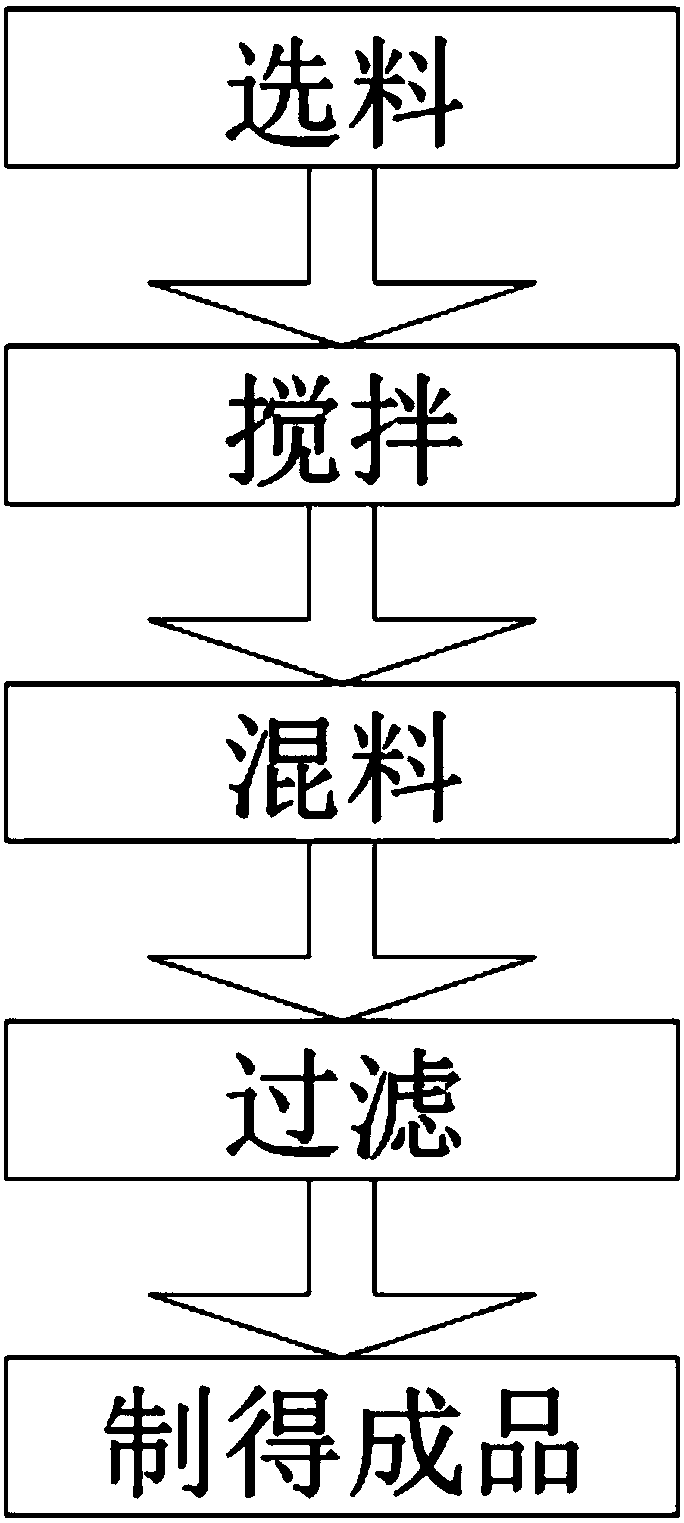Novel antifogging agent for vehicles, and process method thereof
A process method and anti-fogging agent technology, applied in chemical instruments and methods, other chemical processes, etc., can solve problems such as expensive, dangerous, and general anti-fogging agent use effect.
- Summary
- Abstract
- Description
- Claims
- Application Information
AI Technical Summary
Problems solved by technology
Method used
Image
Examples
Embodiment 1
[0031] A kind of novel antifogging agent for automobile, the composition of this novel antifogging agent for automobile comprises by weight:
[0032] Acetylcholine bromide: 1 part;
[0033] Phenacetin: 1 part;
[0034] Sodium lauryl sulfate: 1 part;
[0035] Secondary sodium alkyl sulfonate: 1 part;
[0036] Sodium fatty alcohol isethionate: 1 part;
[0037] Coconut oil fatty acid diethanolamide: 0.5 parts;
[0038] Hydroxy synthetic alcohol polyoxyethylene: 0.5 parts;
[0039] Alkyl glucoside: 0.5 parts;
[0040] Sodium citrate: 0.2 parts;
[0041] Glacial acetic acid: 2 parts;
[0042] Absolute ethanol: 70 parts;
[0043] Hard water softener: 8 parts;
[0044] Preservatives: 0.2 parts;
[0045] Water: 14 parts.
[0046] Wherein, the hard water softener+preservative: water=1:2; the preservative is sodium benzoate.
[0047] A kind of processing method of novel antifogging agent for automobile, the processing method of this novel antifogging agent for automobile com...
Embodiment 2
[0054] A kind of novel antifogging agent for automobile, the composition of this novel antifogging agent for automobile comprises by weight:
[0055] Acetylcholine bromide: 2 parts;
[0056] Phenacetin: 2 parts;
[0057] Sodium lauryl sulfate: 3 parts;
[0058] Secondary sodium alkyl sulfonate: 3 parts;
[0059] Sodium fatty alcohol isethionate: 3 parts;
[0060] Coconut oil fatty acid diethanolamide: 2 parts;
[0061] Hydroxy synthetic alcohol polyoxyethylene: 2 parts;
[0062] Alkyl glucoside: 2 parts;
[0063] Sodium citrate: 1 part;
[0064] Glacial acetic acid: 7 parts;
[0065] Absolute ethanol: 75 parts;
[0066] Hard water softener: 15 parts;
[0067] Preservatives: 1 part;
[0068] Water: 28 parts.
[0069] Wherein, the hard water softener+preservative: water=1:2; the preservative is sodium benzoate.
[0070] A kind of processing method of novel antifogging agent for automobile, the processing method of this novel antifogging agent for automobile comprises t...
Embodiment 3
[0077] A kind of novel antifogging agent for automobile, the composition of this novel antifogging agent for automobile comprises by weight:
[0078] Acetylcholine bromide: 1 part;
[0079] Phenacetin: 2 parts;
[0080] Sodium lauryl sulfate: 2 parts;
[0081] Secondary sodium alkyl sulfonate: 2 parts;
[0082] Sodium fatty alcohol isethionate: 2 parts;
[0083] Coconut oil fatty acid diethanolamide: 1 part;
[0084] Hydroxy synthetic alcohol polyoxyethylene: 1 part;
[0085] Alkyl glycoside: 1 part;
[0086] Sodium citrate: 0.5 parts;
[0087] Glacial acetic acid: 5 parts;
[0088] Absolute ethanol: 60 parts;
[0089] Hard water softener: 12 parts;
[0090] Preservatives: 0.5 parts;
[0091] Water: 22 parts.
[0092] Wherein, the hard water softener+preservative: water=1:2; the preservative is sodium benzoate.
[0093] A kind of processing method of novel antifogging agent for automobile, the processing method of this novel antifogging agent for automobile compris...
PUM
 Login to View More
Login to View More Abstract
Description
Claims
Application Information
 Login to View More
Login to View More - R&D
- Intellectual Property
- Life Sciences
- Materials
- Tech Scout
- Unparalleled Data Quality
- Higher Quality Content
- 60% Fewer Hallucinations
Browse by: Latest US Patents, China's latest patents, Technical Efficacy Thesaurus, Application Domain, Technology Topic, Popular Technical Reports.
© 2025 PatSnap. All rights reserved.Legal|Privacy policy|Modern Slavery Act Transparency Statement|Sitemap|About US| Contact US: help@patsnap.com

